






















Editors-in-Chief
Arjun Jindal – Veritas
Alexander Lawson – Proof
Chiara Martin – Chomp
Cailey Quita – Via Verde
William Xue – Veritas
Xander Yap – Ink
Managing Editors
Henry Germain – Chomp
Doreen Hou – Veritas
Richard Zhang – Chomp
Staff Writers
Divij Motwani, Marcus Ling, Amily Zhang, Salem Coyle, Lara Dumanli, Sarina Grewal, Jeshurun Wang, Mihika Sridhar, Motoko Iwata, Hadrien de Martel, Augustus Soedarmono, Shreyas Shashi, Amani Fossati-Moiane, Mack Reller, Chapin
Walker, Karin Blumenfeld, Vivian Lin, Vivian Tang, Anika Nair
Want to advertise with us?
Scan below for information:

The purpose of this magazine is to highlight the different Incubator publications and showcase the diverse topics and stories our class covers. Incubator is a unique class in that students are able to start publications themselves, and this magazine is a culmination of the creations of Paly journalism students. Incubator represents and values creativity and innovation, which is what this magazine embodies. We hope to highlight all of these diverse topics in-depth, and show how they impact the Paly community.
The Incubator is committed to providing an open platform for diverse voices and perspectives.
Artificial intelligence and the rise of ChatGPT has brought on discussions of the originality of student writing and art. The Incubator as a whole prides our community of unique student writers and has established policies regarding AI-generated works. The originality of the writing and art in this edition has been confirmed by both writers and artists.
Student journalist on any publication in The Incubator will only publish legally protected speech, following the legal definitions of libel, obscenity, and invasion of privacy. Consistent with California Education Code section 48907, the staff will refrain from publishing material (including submissions from the community) which so incite students as to create a clear and present danger of the commission of unlawful acts on school premises of the violation of lawful school regulations, or the substantial disruption of the orderly operation of the school. When faced with potential legal questions, staff will contact the Student Press Center for advice concerning media law.
All printing publications of The Incubator are printed by aPrintis in Pleasanton, CA. Funding for printing comes primarily from advertisements and grants. Copies are distributed free of cost around the Palo Alto High School campus.
This cover, designed by Amani-Fossati Moaine, represents a puzzle of five Incubator magazines. Each puzzle piece represents a different publication, all fitting together to create one.
The photographers and artists who contributed to this cover are Teresa Wang, Ellie Donahue, Divij Motwani, Anika Nair, Karin Blumenfeld, Bobby Daverman and Alexander Lawson.

We are delighted to present our first-ever “Incubator Spotlight” magazine, combining select features of five magazines we regularly publish at Palo Alto High School. This is a good arrangement for us because our class already is a laboratory of Paly journalism startups and offers a smorgasbord of publishing options within a single classroom. We created this combined magazine to show all of the diverse publications the Incubator hosts and demonstrate the talent of
our staff in a way that makes all of these stories more accessible. We start by taking out a bite of Chomp, where we dive into a review on the new downtown restaurant “Marugame Udon,” and find out from Chapin Walker and Augustus Soedarmono if it’s worth the hype. Then follows Ink, where Lara Dumanli and Sarina Grewal explore the contributions of women in literature. In Veritas, things move fast, like Divij Motwani and Marcus Ling’s story on the Stanford SLAC accelerator.
Things heat up further as Vivian Lin and Vivian Tang take a peek into the Fiery Arts club at Paly in Proof. Last but not least, we have Via Verde, where Karin Blumenfeld reflects on her experience working in the coffee fields in Costa Rica and how it’s affected her everyday morning routine. This issue would not be possible without our advertisers and the MAC Boosters, or the guidance and support of our adviser, Paul Kandell. We’re so excited for you to read this Incubator Spotlight!

Editor’s Note:
Welcome to Chomp Magazine! Chomp is the Incubator’s newest publication, and produced its first issue just this past November. This is our third edition, and so far we’ve been overwhelmed by the support from local restaurants, food businesses, and from all of you. Central to Chomp’s mission is showcasing the different ways food can impact our community, and highlighting underground businesses and stories. In this issue, we have done just that. From a feature on Korean hot pot and barbeque, titled “Cultural cooking,” to an inspirational tale “Rollin’ on a different route,” this edition of Chomp demonstrates how food satisfies more than just your stomach. Enjoy Chomp 1.3!
— Chiara Martin, editor-in-chief

“I’ve got to meet my protein goals every day. It’s really important for me.”
“I’m motivated to bring lunch because Gott’s and the Palo Alto area in general is very expensive. I can just pack whatever I’m feeling on a certain day.”
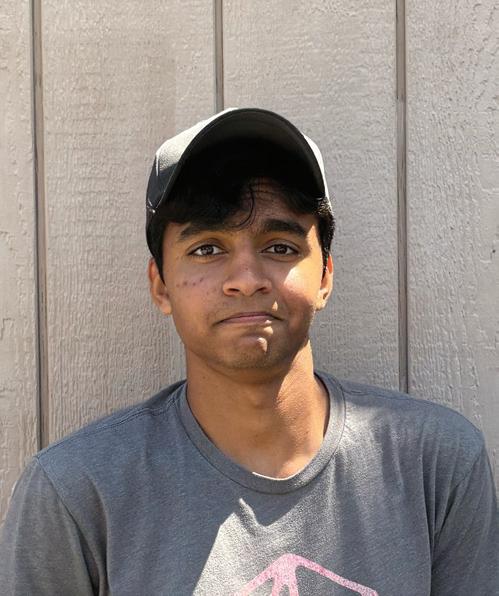

“I think that the school lunch isn’t very healthy so I try to take care of my own nutrition and bring my own stuff to school.”
“I get school lunch. My mom would help a lot when I was a kid making lunches, and now that falls onto me. School lunch takes less time out of my day.”

Serving through a cafeteria-style setup, Marugame offers a glimpse into the process of creating udon, showcasing the steaming noodles, umami soup, and soft beef/chicken.
It also features a tempura station filled with chicken katsu, shrimp, tamagoyaki (sweet egg omelette), sweet po-
To finish the cafeteria setup, the drinks section features classic Japanese drinks, including Iced Matcha, Calamansi and Oolong Tea.
Upon entering the restaurant, a large photo of “Ways to Eat Udon” greets customers, guiding them through the process. Surrounding the cafeteria-style setup, the ambiance of the

restaurant gives a modern feel, with up to date seating, and serving stations.
In the Palo Alto area many asian restaurants such as Ramen Nagi, Dumpling hours, and Fuki-Sushi gives this restaurant a lot of competition off the bat, making it even harder for them to create a steady customer base.
Tonkotsu Udon: 13.29 for regular and 14.99 for large
The Tonkotsu offers freshly made Sanuki-style udon that has a soft yet chewy base. The broth is bold and intensely salty, which may overwhelm some palates. The pork is tender and adds to the richness of the dish, but the portion is noticeably small. The udon noodles themselves lack flavor and rely heavily on the broth to carry the dish. Overall, the strong broth and minimal toppings leave the bowl feeling unbalanced.
Nikutama Udon: $12.55 for regular and $13.95 for large
The Nikutama offers freshly made soft, yet chewy udon. Along with the noodles, the soup broth pairs nicely, creating a hearty taste. However, paired with the udon and broth, the sweet beef had a rough texture an felt very average compared to the hype the restaurant received. Finally, with the addition of the crispy onions and scallions, the texture of the udon became soggy and mushy.
Tan Tan Udon: $12.25 for regular and $13.65 for large
The Tan Tan Udon provides vegetarians an option to enjoy the soft udon through their sesame chilli broth, seasonal veggies, and a spicy ground soy. Despite advertising that the udon was spicy, in reality the dish had minimal spice and a light sriracha flavor.
Fried Squid - $2.25 Fried Gyoza$4.50
Both the fried squid and gyoza fell short. The squid, despite being soft inside, had a doughy texture from the batter and tasted bland with no seasoning. The gyoza was over-fried, creating the texture of a chip rather than a soft and crispy potsticker.

Text by HENRY GERMAIN and RICHARD ZHANG
Photos by HENRY GERMAIN
Located on the bustling El Camino Real, Fambrini’s has quietly built a reputation for serving delicious food with a slight gourmet twist. Lines form the second the restaurant opens, and it is still packed when it comes time to close.
Fambrini’s makes the most of the warm California sun with lovely outdoor seating for guests to enjoy their food, which adds to the laid-back vibe of the restaurant.
Although Fambrini’s serves tasty
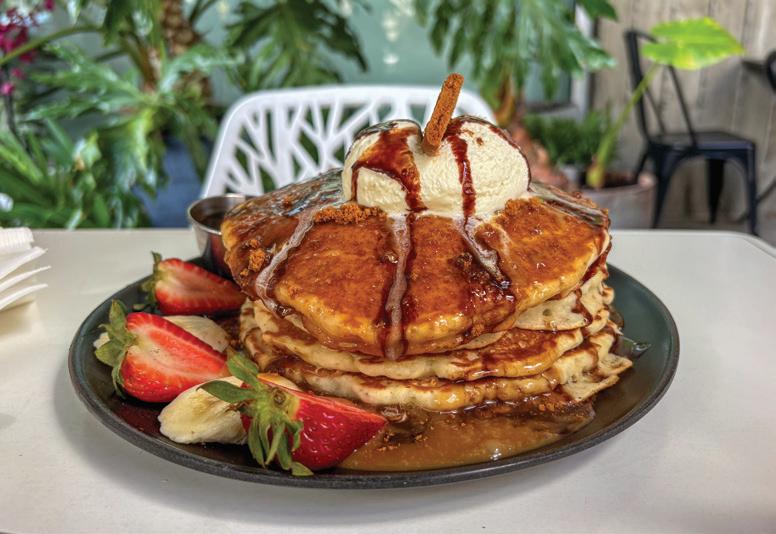
Surf and Turf Sandwich - $19.50
meals and provides quick service, there seems to be a reason that Fambrini’s hasn’t become a Paly hotspot during lunchtime. Whether it’s the high prices or simply the lengthy travel from Paly, the cons just seem to outweigh the pros for students.
One certain way to turn more heads in the Paly community is to make a lunch deal exclusively for students. Fambrini’s manager, Manlio Figueroa, spoke about the possibility of launching a Paly special sandwich in an interview.
“I think it’s important to get more benefits for the students, so there is a chance,” Figueroa said. “But one of our challenges is that we have very limited parking, so our location may not support a ton of students driving over for lunch.”
So, if a Paly student deal isn’t released, should you spend the money and time to pay Fambrini’s a visit? Should you bother even if a Paly lunch is introduced?
We tried a few dishes at Fambrini’s to answer your questions.
Fambrini’s signature Biscoff Pancakes, based off of the iconic cookie, did not disappoint by any means. The fluffy stack of pancakes is layered with a Biscoff spread, adding a caramelized flavor with hints of warm cinnamon. Drizzled over is a generous serving of sugary and silky syrup, creating rich flavor without overdoing it. On top sits a dollop of thick whipped cream, adding a coolness to the dish that balances out the warmth from the pancakes. Finishing off the dish are the Biscoff crumbles sitting atop the giant stack, adding an appeal that no one can resist. This dish is an indulgent treat that feels like a dessert disguised as breakfast, but perfect for anyone with a sweet tooth.
This Chimichurri sandwich is full of herb flavoring and is packed with tender homecooked tri-tip. On top of that, the addition of jumbo shrimp creates a surf and turf sandwich unlike any other. The chimichurri sauce seeps into the tri-tip, giving each bite a garlicky taste with a kick of spice. Alongside the juicy steak, the jumbo shrimp with its salty and ocean-like taste creates a contrast of flavor to complete this surf and turf sandwich. Topping off the meats, fresh produce like lettuce and tomato adds a final satisfying touch to each bite. Finally, served on a signature handmade ciabatta bread, the sandwich strikes a balance between texture and flavor, with the bread acting as a foundation for this delicious sandwich.

The omg sandwich - $19.50

The OMG sandwich is the perfect choice for any meat lover, loaded with a dynamic array of meats. Consisting of bacon, tri-tip, salami, and pastrami, the flavor of the sandwich pops in your mouth, with each meat activating different palates, from savory to a hint of spiciness. Underneath the thick layer of meat is the classic combination of lettuce and tomato, its juiciness pairing perfectly with its counterparts. Melted on top is a cheesy layer of provolone, a much-needed touch to the sandwich by adding essential creamy texture. To pull everything together, Fambrini’s signature garlic sauce is drizzled over the sandwich and makes each bite recognizable as a Fambrini’s sandwich.

Especially in the Bay Area, there’s an expectation that college should immediately follow high school graduation. But in Redwood City, 19 year old Jonathan Maldonado followed a late night craving, paving a different path.
Maldonado started “Fire Hibachi,” a food truck located on 1690 Broadway in Redwood City. Based off of his cravings for local Japanese restaurant “Sakura Teppanyaki and Sushi,” Maldonado sought to mimic the cuisine but in a late night and on-the-go version, with a food truck that closes at 11 p.m.
October after graduating high school at just 19 years old, with no culinary nor business experience.
“I tried college for a little bit, but I realized that it wasn’t for me,” Maldonado said. “And I had this idea, so I figured it couldn’t hurt trying. Then I put my time into starting this business, and it’s been really good for me so far.”
“If you have an idea and you work hard enough to pursue it, it will come to life.”
— Johnathan Maldonado, Owner
“I was craving Sakura late at night and realized that they close pretty early, and also that there weren’t any Hibachi food trucks in redwood city,” Maldonado said. “I put two and two together and I decided to try it [starting his food truck] out.”
Maldonado started Fire Hibachi in
Taking inspiration from Sakura and through trial and error, Maldonado carefully put his own spin on his favorite food, offering a variety of hibachi inspired dishes.
Its most popular dish is the burribachi ($21.95), which takes traditional sauced up hibachi elements (noodles, fried rice, protein etc) and wraps them in a warm tortilla. This fusion dish is yet another example of the bay area showing its history through food.
Although finding success with the dishes, other parts of the journey hav-
en’t been as easy. Luckily Maldonado has help from his cousin, Yedie Sanchez, who is also a local business owner.
“Because I’m still young, people try to take advantage of me,” Maldonado said. “A lot of people try to overcharge me because they think ‘Oh, he's a kid, he doesn’t know how much anything costs.’ So my cousin has been a major help with that.”
Even though the truck is only seven months old, Maldonado is excited for what comes next.
“I want to expand to other locations and have more food trucks, maybe even a restaurant,” Maldonado said.
In a community where it seems like college is the only option after high school, Maldonado is an example of someone pursuing an alternate route. He would advise any high school student not sure of what to do to go with their gut and trust their ideas.
“In the beginning it’s a bit scary, but I would say go for it,” Maldonado said. “If you have an idea and you work hard enough to pursue it, it will come to life.”
Text by MARCUS LING and DIVIJ MOTWANI
The sounds of indistinct chatter and laughter fills the halls of the restaurant, as the smell of barbecue sauce drifts through the air. As we walked through the restaurant, tongs clashed and beef sizzled. At each table in the Korean barbecue restaurant Superhot located in Mountain View, a grill separates diners, but their interpersonal connection remains closer than ever.
The act of cooking one’s food with family and friends is deeply woven into the fabric of Korean dining culture, allowing for social endeavors centered around food. Korean Barbecue, or “gogi-gui,” has roots spanning back centuries, evolving from various grilling customs. Historically, these communal meals strengthen social bonds between people, a trait that continues at Superhot.
Starting at $36.95, this all-you-caneat restaurant offers grilled meat and
hot pot. Patrons have 90 minutes to eat and are presented with a menu of a vast variety of meat choices. Diners choose from plates of uncooked marinated beef, chicken, pork, and fish, which they cook themselves in the center of the table. Alongside this uncooked food, the restaurant offers many options of desserts and cooked dimsum. The service is very fast, and waiters are always ready to take another order
To learn more about the cultural significance of Korean barbecue, we interviewed Palo Alto High School senior Christopher Choi.
“In Korean culture, we generally consider Korean barbecue as food for celebration or coming together on special occasions,” Choi said. “It’s not something that we have as an everyday meal, because eating a large amount of meat in a single sitting gets expensive very quickly.”


Choi remembers those meals less for the occasion and more for the feeling of cooking side by side with his family.
“Despite the cost, though, I have good memories of special occasions throughout my life where I’ve spent an hour or two grilling at the table with my family, and I think that the communal aspect makes it worth it,” Choi said. “I think that a key way that Koreans bond is through food, and cooking at the table is just about the purest way that you can do that.”
—


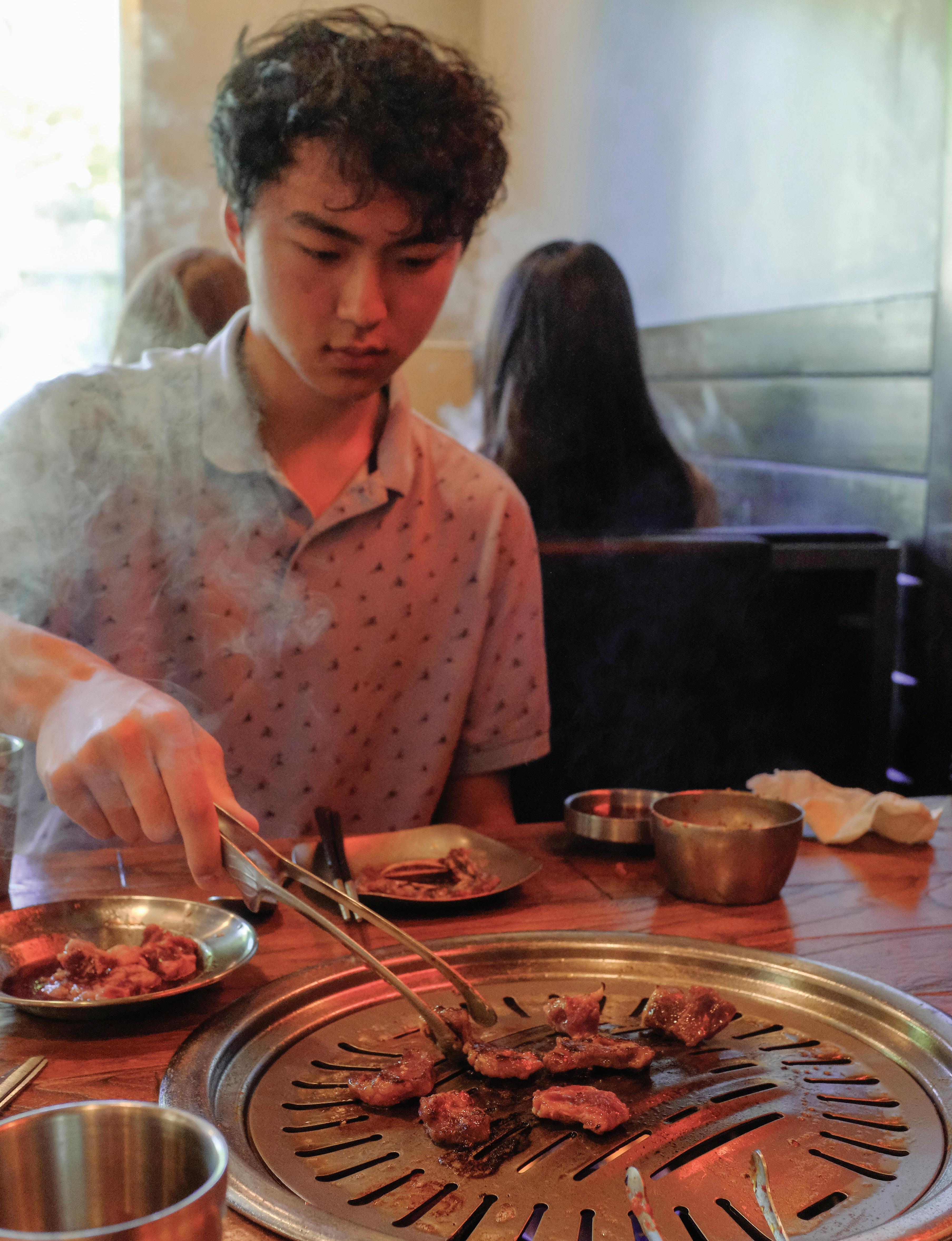

Editor’s note:
We are delighted to present Ink’s eleventh print issue! Writing can be sometimes feel like your climbing up a hill on one foot while fighting a dragon. And those dragons are the best part. Thats why this cycle our theme is fantasy, all of the dragons with none of the pain. Ink is combining with other incubator publications to showcase the best work of the incubator class. In this cycle we showcase a range of storytelling where staff writer Mihika Sridhar reflects on the fate of disney movies to staff writer Salem Coyle who explore new themes in the digital media.
Submit to inks next issue at www.inkliterarymag.org/submit.
– Xander Yap, editor-in-chief

Text by Motoko Iwata and Xander Yap
Tara Sim, a local young adult and adult fantasy author, has followed her dream of being an author despite many challenges.
Writing has been a dream of Sim’s since she was little.
According to Sim, she has evolved as a writer.
“Growing up, I would be really interested in telling stories,” Sim said. “But it really wasn’t until I was 14 or so where I decided I really wanted to write fantasy books specifically.”
Sim said that growing up in a diverse area played a large role in her writing journey.
“Growing up in such a diverse area that the Bay Area is, I was introduced to a lot of ideas, and a lot of open mindedness,” Sim said. “That definitely skewed my writing toward that open mindedness … Different kinds of
Hayley Dennings, the author of This Ravenous Fate, writes to be a voice she never got to read.
Born and raised in the Bay Area, Dennings found the area played a large role in her writing career.
Dennings said that the diversity of the Bay Area supported her.
“Living in the Bay Area, and specifically Oakland, it’s a very diverse area,” Dennings said. “There are so many different cultures that mix here, and so I’ve always grown up seeing queer people and people of color … I am lucky that I found my people.”
In contrast, Dennings felt that the media didn’t reflect her.
“I didn’t see a lot of books or people in general in the media who looked like me,” Dennings said.
According to Dennings, this played a large part in developing her purpose
people and backgrounds and experiences.”
According to Sim, local resources have also played a big part in supporting her.
“A lot of the things that I have done in my own journey to become a published author was that I attended the San Francisco writers conference,” Sim said. “That was pretty eye opening, because you get to interact with a lot of people just like you who want to get published, who love writing, and who love books.”
Sim said that any aspiring writers should grasp such opportunities.
“Getting out there, both online and in person is really important,” Sim said.
According to Sim, despite difficulties, authors can succeed in the industry with perseverance.
“It’s going to be very difficult,”
as an author.
“My goal with writing this book was to give more visibility to the black experience in the US.” Dennings said. “There’s a lot of things that I explored in my book, mostly because of my own experience as a black woman.”
Dennings said that she drew on the rich history and culture of the Bay to found her work.
“There’s a lot of black history that’s come from Oakland,” Dennings said. “In writing a historical [novel] and wanting to tell a more nuanced perspective of black history, I had to tap into everything.”
Dennings said that she’s received a lot of support in her journey.
“Publishing and writing can be a very lonely activity,” Dennings said. “Having people around you to support you is great.”
Dennings advised on the impor-
Sim said. “It takes a toll on you, both emotionally and physically. And I don’t say this to deter anybody, but you have to be persistent. If love for writing is there, if you want to keep doing it, you have to hope for the best and prepare for the worst, because it’s very much a roller coaster.”

tance of mindset in becoming an author.
“You just have to do it,” Dennings said. “You should be your biggest fan from the beginning … You really just have to trust yourself.”

It’s time to respect the contributions of women in literature
To us, English has always been a space for women.
Growing up tucked in the deepest shelves of the library, we both spent our early years tearing into books like we were starved for knowledge. It seemed like everywhere we looked, girls were the forerunners for anything reading and writing related, whether practicing cursive in a sparkly pink diary in elementary school or completing assigned reading weeks in advance in high school. The stereotype that girls were supposed to be better at reading than boys surrounded us throughout our educational lives.
whom it was unquestioned that I could go into the professoriate if I wanted to, and I’ve certainly always seen women at the table.”
I had female professors who, themselves, had not had female professors.
— Lisa Mendelman, Associate Professor of English and Digital Humanities
To be fair, these assumptions weren’t unfounded. A 2022 report from the National Center for Education Statistics said that 15-year-old American girls have a significantly higher level of reading literacy than boys their age. From an early start, American girls are at an advantage in their consumption and understanding of works of literature. Even as adults, women tend to read books at a higher rate than men, as a 2017 report from the National Endowment for the Arts found.
In academic circles, women have become more and more integrated in academic infrastructure. Lisa Mendelman, an Associate Professor of English and Digital Humanities at Menlo College, comments on this shift.
“I had female professors who, themselves, had not had female professors,” Mendelman said. “But I’m now part of a generation of female scholars for
In commercial spaces, marketing books towards women has become industry standard, as demand for romance novels and young adult fiction soars. Pushed along by online helpers like TikTok and Goodreads, female authors like Sarah J. Maas and Rebecca Yarros have soared to the tops of bestseller lists, drawing in audiences from a wide range of ages. Fantasy was the strongest-selling genre of adult fiction in 2024, according to Publishers Weekly, so the commercial market clearly values the genre.
Yet despite their increasing popularity in the commercial publishing industry, women aren’t receiving the same awards and critical acclaim as men. According to a 2023 paper from the National Bureau of Economic Research, female authors produce roughly half of books published each year, yet their share of literary awards like the Pulitzer Prize stand at only about 30%.
Such awards are often used to determine works with literary merit and mark the boundary of what is considered “serious literature.” So, when women are held back from these spaces, their ability to gain recognition and prestige become inhibited, deepening the chasm between male and female authorship.
Despite the common
mainstream perception, female authors are emerging across all genres, not just in Young Adult or Romance, where they are often relegated to. Nonfiction and academic publications are seeing surges of female authorship, and it’s critical that their contributions to the literary sphere be recognized alongside their male counterparts, especially with awards that grant them the credibility they deserve.
“For as long as we have had women writers, we’ve had this expectation that they write domestic fiction, and when they’re not writing domestic fiction they’re writing like men,” Mendelman said. “We still live in the shadow of this perspective today.”
It’s imperative to appreciate female literature, but it must be acknowledged that the authors behind these works are women. The female authors of the world deserve to be acknowledged as valuable contributors to the literary canon in their own right, without the brand of their gender holding them back.
America descends further into anti-intellectualism every day. In this critical period, reading and recognizing female authors for their skill becomes more important than ever. English has long been a space where women are expected, but it’s past time for it to become a place where women are equally respected.
text by sarina grewal and lara dumanli art by lara dumanli

The newest addition to Rebecca Yarros’ Empyrean series falls short of expectations
With the rise of the extremely popular BookTok community on TikTok, one book caught the attention of millions of readers on the platform: “Fourth Wing”. The “Fourth Wing” series by Rebecca Yarros, also known as the empyrean series, has already sold over 12 million editions in the United States and is one of the most successful career starts for any author.
However the newest addition to the series, “Onyx Storm”, fell greatly under expectations for me. Subpar word building, underdeveloped side characters, and an overly stretched out story that felt like plot filler made “Onyx Storm” underwhelming.
A quick recap of the series: the books are based in the kingdom of Navarre, a military dictatorship where the ruling elite train to become dragon riders, and are written from the perspective of Violet Sorrengail. Violet is the daughter of one of the most important generals in the millitary, and throughout the series she must maneuver through friendships, politics, and divided loyalties as the war between the dragon-riders and the venin (dark magic users) continues to escalate.
In “Onyx Storm” Yarros leans further into the epic fantasy genre, and expands on the world of the Empyrean series beyond Navarre. Violet and her quest squad venture out to a series of remote islands on the edge of the world in order to look for reinforcements, and in doing so the reader encounters new societies, new characters, and magical creatures. But, each of the islands follow the same formula, making it very repetitive. Violet and her quest squad arrive at the island, she faces some sort of threat or challenge, then she discovers part of a truth, then she escapes and moves on.
After visiting 6 different islands, the repetitiveness makes it boring,
and many of the revelations were overly convenient as if inserted to patch plot holes. For these reasons, I felt the world-building and quest in general didn’t reach its full potential.
Yarros also attempted to introduce a variety of new side characters in “Onyx Storm”, but the characters were underdeveloped, and I never really felt a connection with them. Since there was no real backstory for these characters, and we never really got to know them, there is no reason for the reader to particularly care for them. The addition of a dozen or so new characters in the quest squad and the constant barrage of new characters in the island civilizations just makes it really hard to take a liking to a particular character, and makes it difficult to follow who is who.
I thought Yarros did a pretty good job with the side characters in “Fourth Wing” especially with Liam, a cadet at the dragon rider acade my, but these new characters really just didn’t work for me in “Onyx Storm”. The novel could’ve bene fitted from multiple perspectives, like most longer fantasy series such as “Lord of the Rings” or the “Stormlight Archives” so that the reader could really get to know the side characters.
Lastly, the novel felt like a filler book. There was an overwhelming amount of reveals, cliff hang ers, and random sto rylines that didn’t really contribute to the plot of the story. The book also had a major pacing problem with long boring chapters, and the majority of the story felt pointless.
This may be attributed to Yar ros deciding early on to
change the Empyrean series from a trilogy to a five-book series.
“‘Probably about 30,000 words in, I called my editor and I said, I think this is a five-book series,’” she told Variety in 2023. “And that’s how we went from three to five.”
But in my opinion, the series would’ve been better off as a trilogy. Most of the pacing problems with both “Iron Flame” and “Onyx Storm” could’ve very easily been avoided if Yarros hadn’t decided to write extra two books.
That being said, I still believe that the next two books in the series could be fantastic if Yarros adds more perspectives, focuses on developing the side characters, and works on the pacing issues in “Onyx Storm”. It may not be at the same literary level as J.R.R

Text by Mihika Sridhar and Amily Zhang
Snow White” is one of the most controversial movies of the year. From the use of CGI for dwarves to the lack of racial differences, people have found issues with almost every aspect of the movie. All of these problems are the beginning of the end for the movie.
The biggest problem of the movie in our opin ion is the way the movie tried to promote diversity. There is no reason that the dwarves should have been CGI. The whole point of having a movie to increase diversity is casting people who are different from the norm. Actress Katrina Kemp, a frequent advocate for the inclusion of people with disabilities, said that Disney missed out on the chance to normalize dwarfism in an interview with MovieWeb.
"It's a missed opportunity to make a movie with seven little people where they actually have intended charac ters,” Kemp said.
For a movie focused on trying to in crease diversity, it is a massive fail. “Snow White” is played by Rachel Zegler, who is of Colombian and Polish ancestry. The “prince”, the Evil Queen, and all seven dwarves are white. The only other prominent character of color is the Huntsman, who is played by Ansu Kabia. He is mixed, with his father being African and his mother being white. Con sidering there are thou sands of talented ac tors who aren’t white, there is no reason that the cast should be overwhelmingly white.
Here in Palo Alto, a community is filled with people of dif ferent cultures and back grounds diversity is just a part of everyday life. However, that's not a reality for many people in the United States. Because of that, movies are how most people

get exposed to different cultures. “Snow White,” for all the promotion it did on the importance of diversity, fails to represent different cultures and only reinforced the idea that the majority of “qualified” actors were white. Now, if that were the only issue with the movie, it would have just been a mediocre movie. Alas, that was the tip of the iceberg. Another failure is the overall storyline doesn’t
To many people, “Snow White” and other Disney princess movies are their childhood. They do not want to see Disney producing these movies for the sake of having an economic claim. Disney is trying to replicate its past storylines but for the purpose of trying to rein in more money. This exploitation of the past lacks luster and is not working. It does not incentivize people to watch the movies, in fact it does the opposite. Nobody wants to watch movies that feel as though they were just made for money. These movies should be reproduced to replicate the feelings they felt for the newer generations. Instead, we get a watered down version of the magic of the originals. The new movie takes away from the magic of the old one. Instead of people thinking of the original “Snow White” with the animated birds flying across the screen and the colorful flowers, they will think of the live-action movie that tried too hard to be good and became an utter failure.
Hopefully Disney sees the backlash from this movie and doesn’t rush into making the next one. The “Snow White” live-action movie is one that the people and the characters do not deserve. Instead of trying to replace the magic of the original with a subpar substitution, the live-action movies should strive to create new experiences for the future generations.
So read the opening lines of “Deltarune” — white, pixelated text, against a black background, within a small game window. Three years after the breakout success of his prior indie game, “Undertale”, developer and composer Toby Fox released the first demo of “Deltarune” on Halloween Day of 2018.
Though only two chapters are currently playable out of an intended seven-chapter release, both segments have received stellar reviews thus far. “Deltarune” is intended to be Fox’s magnum opus, with the ideas motivating its development tracing all the way back to 2011. And it shows — along with an overall heightened production quality, “Undertale” is full of nods to “Deltarune”’s narrative, from years before its release.
Fox is no stranger to incorporating the fourth wall as a major element in his works. “Undertale”’s thematic core is tied to the responsibility a player holds over a game world—both the good and bad they can produce through their unique ability to respawn. “Undertale”’s story is fundamen tally based in its existence as a game, and the acknowledgement of its resulting pow erlessness against your actions as a player.
And these fourth wall breaking themes extend to his current work on “Deltarune”. Even within the first couple sections of the story, the line between player and character has already been blurred, if not outright re moved. Your connection to “Deltarune”’s world is only possible through taking control of its protago nist, Kris, and their actions.
The act of having a protagonist in it of it self is common to most video games. But even in this fashion, “Deltarune” differs from the norm. Kris is the vessel you control, but Kris isn’t you; they possess their own life, one with a history extending far before your entrance. And they aren’t happy with many of the choices you make on their behalf, often bend ing your dialogue inputs in ways that better convey their true feelings, not yours.
Yet, the agency that Kris possesses over them selves is incredibly little. This forced takeover of a pre-existing person is just one fourth wall breaking
element that adds to “Deltarune”’s themes and narrative. Though the player may at times forget it, they are always reminded in one way or another that, in engaging with “Deltarune” as a game, they strip its main character of choice or input. Through this, the ethics of playing “Deltarune” at all are called into question—is it fair for us as players to forsake Kris’s feelings when they seem so discontent at being under our control? Do our feelings triumph over the feelings of a game character? What makes us think our choices hold more importance than theirs?
Much like we take the power of choice away from Kris, “Deltarune” also takes the power of choice away from us. In stark contrast with “Undertale”’s 93 unique possible endings, Fox is insistent that “Deltarune” only ends one way, a fact plastered all over its store pages. And the game itself insists similarly. From beginning to end, “Deltarune” tells you over and over again that your choices don’t matter; and it’s right. No matter what you do as Kris to try and alter the narrative, no matter what dialogue options you choose or the way in which you interact with enemies, both chapter one and chapter two always end in the same way.
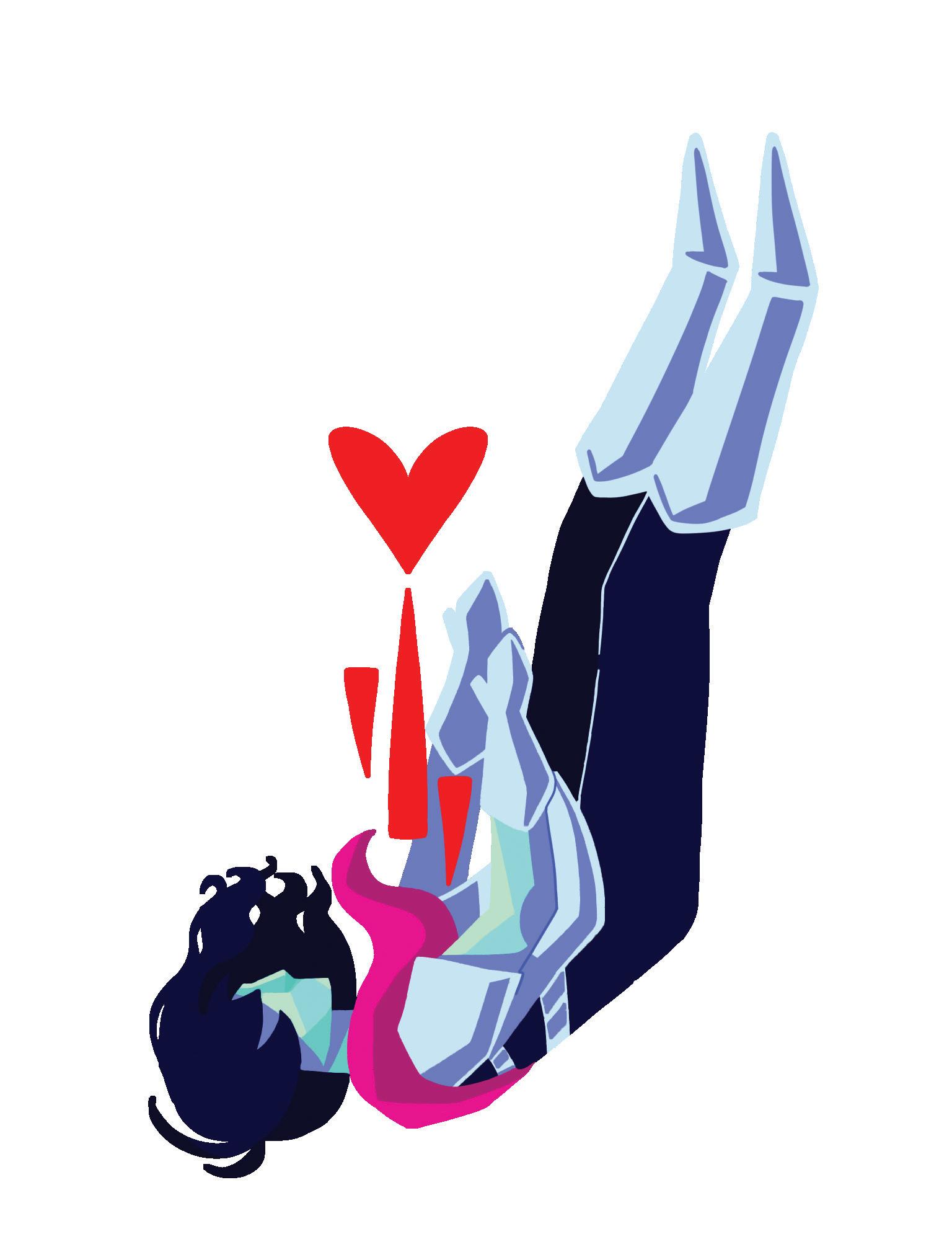
The linearity of “Deltarune”, too, toys with the gap between the player and the game. The norms created in “Undertale”— mentioned by the game itself to be ‘required playing’ before “Deltarune”— are both harshly subverted and built upon in its spiritual sequel. The fourth wall is manipulated, with the player’s existence made central and narratively impactful, in both games.
But the themes they aim to convey could not be more starkly different. Where “Undertale” stresses the power of choice, the unique ability of a player to impact a game world to their liking, “Deltarune” instead uses the player’s power to emphasize their helplessness even more.
“Deltarune” Chapters 3 and 4 release on June 4th, 2025, and will be available on Steam, Nintendo Switch, Nintendo Switch 2, PlayStation 4,

Editor’s Note:
Welcome back photographers and artists! We are excited to present the latest issue of [proof] magazine after our brief hiatus this year. Published three times annually, [proof] is Palo Alto High School’s fine arts and photography magazine, working to showcase Paly’s vibrant and diverse artistic community, covering a variety of styles and backgrounds. Our first issue of the 2025 school year focuses on showcasing artwork from the Paly student body in various different ways. AP photo student profiles, a feature of the glassblowing club, and a high quality student photo gallery all come together to showcase the artistic talent present at our school.
— Alexander Lawson, editor-in-chief
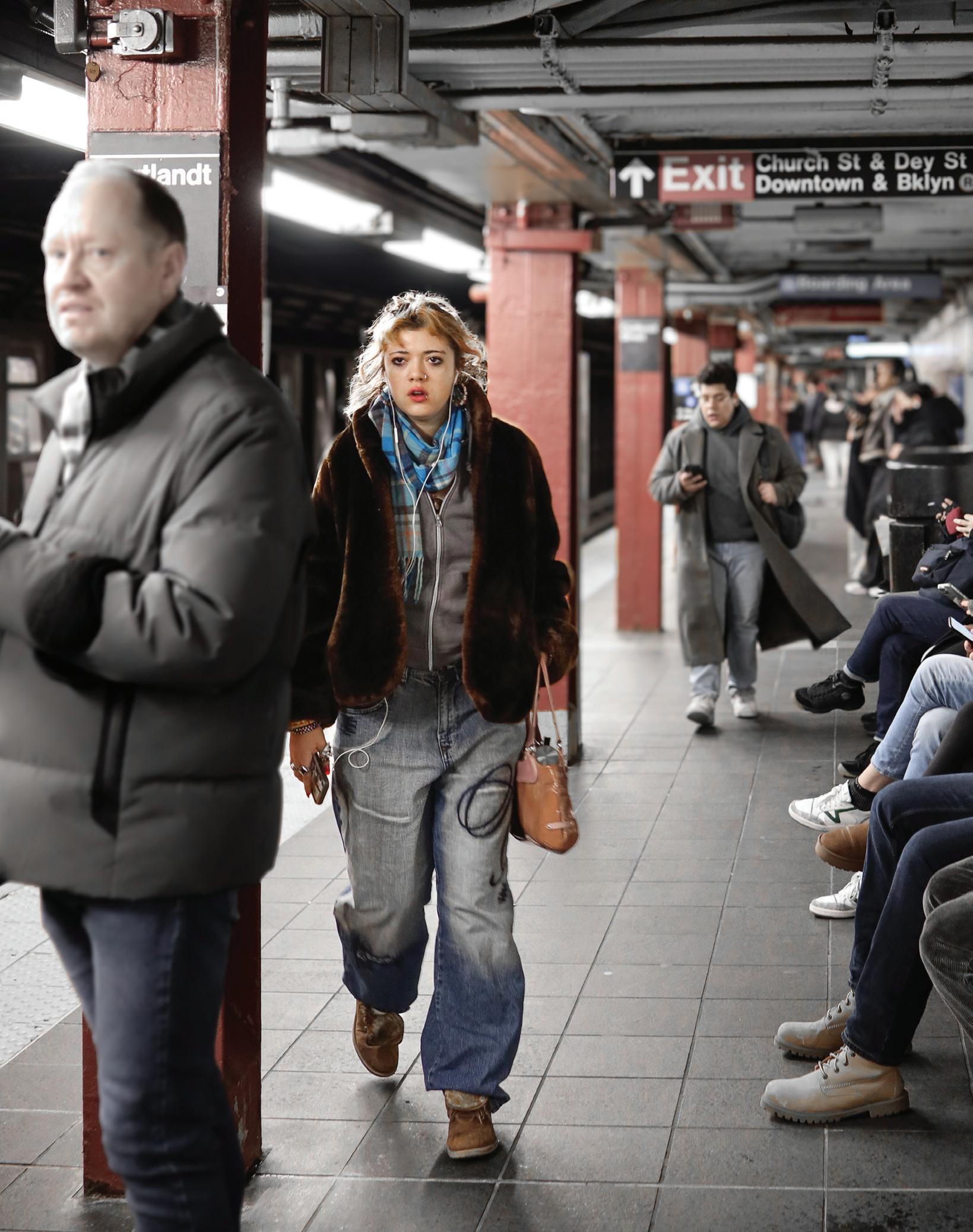
If Paly students are seeking an opportunity to further their photography skills, the best way to do that is through AP Studio Photography. This course is designed for students to end up creating a diverse and professional portfolio. We interviewed two student photographers, juniors Tarika Pillay and Kae Huang, to see how their photography has evolved over their time in the photography pathway at Paly.
Story by AMANI FOSSATI-MOIANE and CHIARA MARTIN


What sparked your passion for photography?
Tarika: I come from South Africa, where I had my first camera ever. When I moved to the States, my mom had told me that there were photography classes in the school I would be enrolling in, and I had been told that the amateur photos that I had taken so far were really good. So I enrolled in the photo class, and ever since then, I've just been improving my photography. Every day that I get out and take photos, and I get to sit behind my camera and create something, sparks a new passion .
Kae: I started taking photos around fourth grade. My dad has had this camera ever since I was born, so I just picked it up. We used to go to national parks a lot, so I'd always have a camera on me. It was a canon, one of those small digital cameras. And then I picked up a DSLR in sixth grade. And then I was always excited. I was like, ‘Oh, is there a photo class in middle school? I'm interested in this.’ But there wasn't. As soon as I got into high school, I enrolled into the Photo pathway and it's been fun so far.
Tarika: The best way for me to express my emotions is through photography, because I really strongly believe a photo can say 1,000 words that I can never write, even if I had all the time in the world. All these emotions that I have get filtered through my camera. There are some photos that bring me pain every time I look at them, because it's such a raw depiction of my emotions.
Kae: One thing I appreciate the most is just the school and the resources that it gives us. Having Mx. [Kenna] Gallagher as a teacher as well is really nice. I've learned a lot from them. But honestly, I'm more independent, so I guess just going out and taking photos and just having that equipment really helps.
Tarika: Whatever college I go to, I’m going to have a minor in photography. It’s kind of just weaved itself into my everyday life. I can’t imagine life without it. So I’m gonna try and take it and go out and take pictures the best I can. I’ll incorporate it into my daily life as I grow up and move on from Paly.
Kae: Honestly, I think I’m not really going to do a lot about it. I might do photography on the side. I’ve sold a couple photos before, but I don’t think that’s gonna become like a big thing. It’s just going to be a family and friends or a here and there thing. But I am majoring in art, so maybe it’ll help in the future.
text/photos by vivian lin & vivian tang
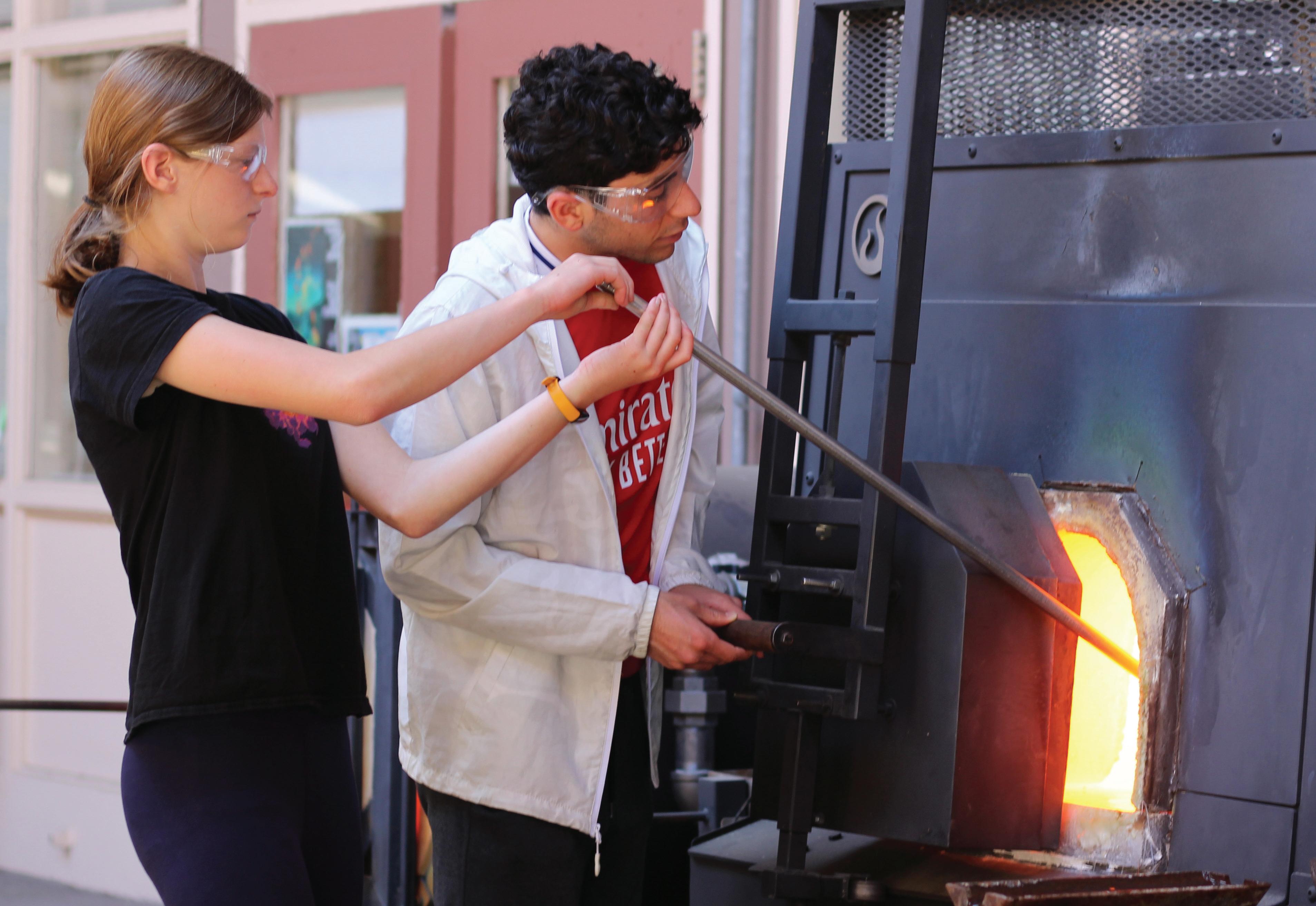
Standing in front of a heat-blasting 2000 degree furnace, senior Zachary Crystal, equipped with safety goggles, concentrates on spinning a metal rod with molten orange glass on its end. He takes the glass bubble out of the furnace, using a jack to shape the quickly hardening glass. Crystal is part of a small group of students in Palo Alto High School’s Fiery Arts Club.
The Fiery Arts club started last year with Crystal as its vice president.
“I mean, there are only four high schools in the country that have a glass blowing studio,” Crystal said. “… So by joining and being a part of the leadership of the glass club, I wanted to give other students the opportunity that I had to try out this form of art.”
Senior and club co-president Sophia Kelly says that due to the small number of students who participate in glassblowing, the club ends up fostering a very tight community.
consistently come to the club, but those who stick around and actually learn how to make items show curiosity and you become pretty close.”
Crystal said he especially enjoys teaching his peers glass blowing and seeing their progress.
“It’s seeing students that haven’t tried out glass blowing kind of improve throughout like just one lunch period,” Crystal said.
“There’s not a lot of us who do glassblowing or who consistently come to the club, but those who stick around and actually learn how to make items show curiosity and you become pretty close.”
— Sophia Kelly, co-president of Fiery Arts Club
“I would say [we have a] tight knit community,” Kelly said. There’s not a lot of us who do glassblowing or who
“They already get drastically better just from a little bit of experience. So sweeing that progression is really cool.”
“I hope people gain some appreciation, also insight into how to make things, and also just have some fun,” Kelly said. “Glassblowing is not something you get to try every day, and having it as a public high school, I think it’s pretty cool.”
Crystal said that once he graduates, he will miss the people in the club most.
“You get to become really good friends with them and you’re seeing them in class every day and at the club, and it’s just that repetitive kind of interaction that kind of even a habit for me now is gonna be sad to leave.”

GUIDING FLAME:
Senior Zachary Crystal helps a new club member fire their glass in the furnace as they navigate through their first glassblowing experience (top left).
HYPERFOCUSED:
Senior Sophia Kelly shapes the quickly hardening glass of her new creation as she uses a jack and rolls the blow pipe back and forth (top right).
MELDING A CREATION: Senior Sophia Kelly uses her jack to shape her glass into a mushroom (bottom right).
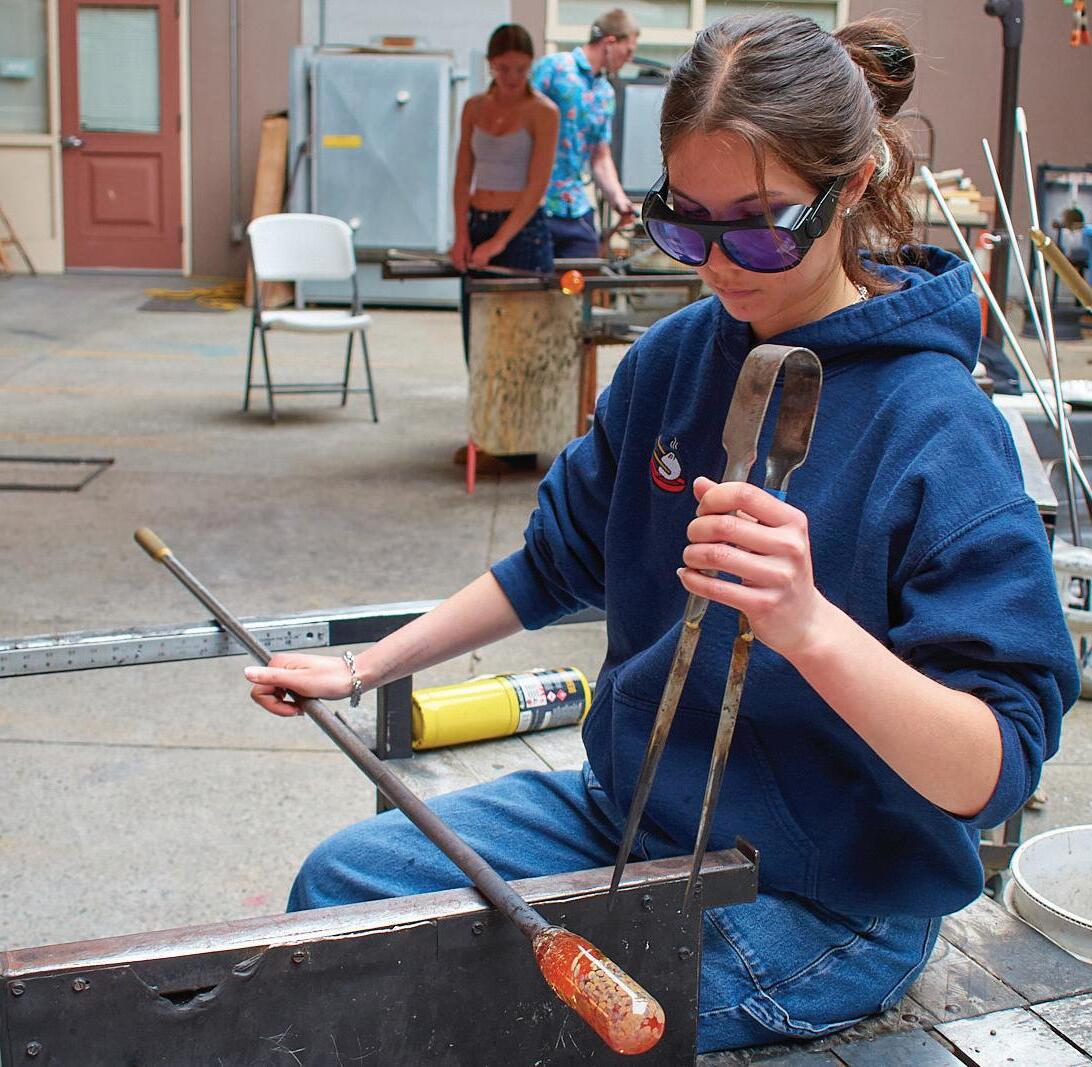

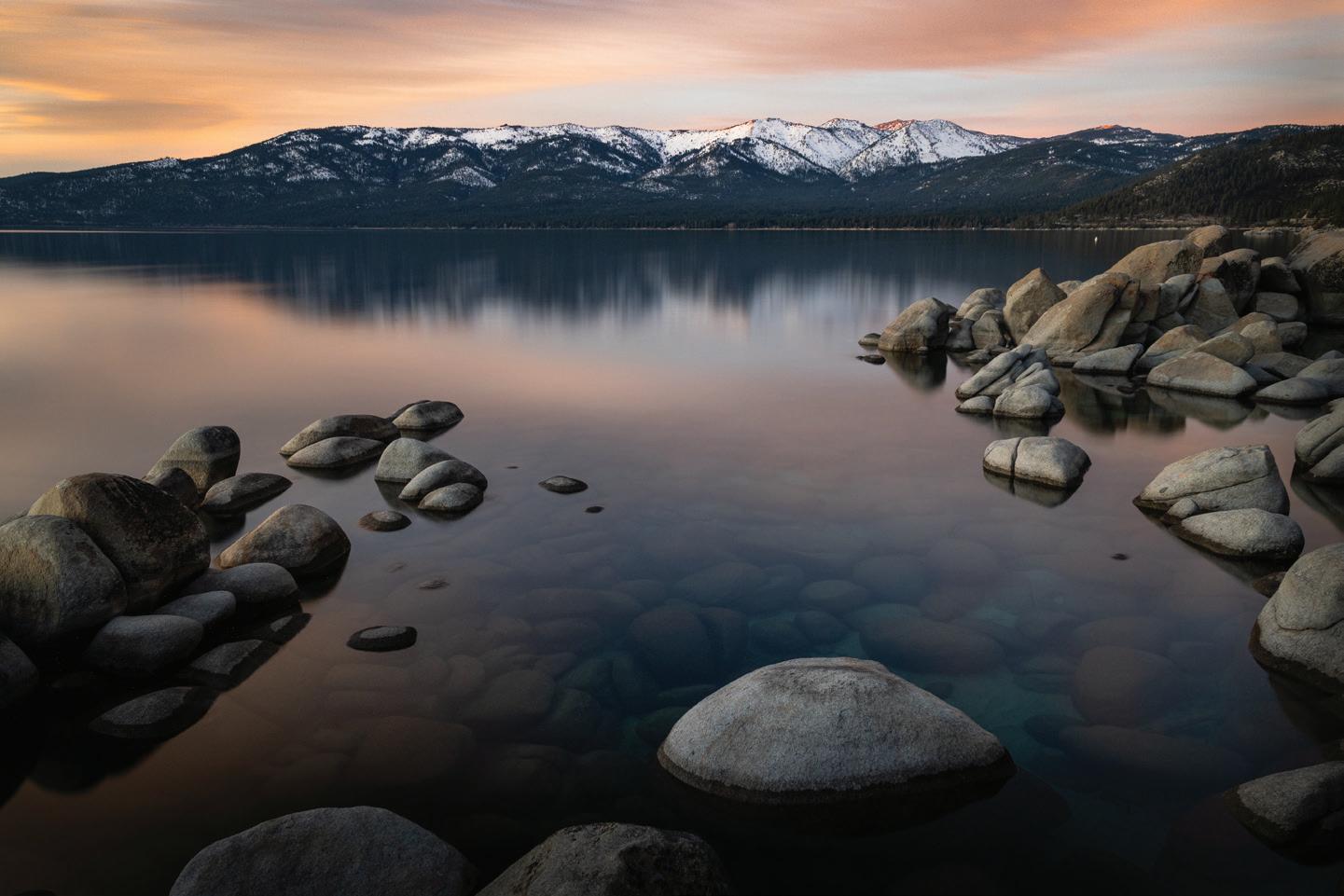



We are so grateful to have received so many high quality submissions for our spring 2025 student photo gallery! Email proof.paly@gmail.com or visit the link in our Instagram bio (@proof.magazine) to submit for our next issue in fall 2025.





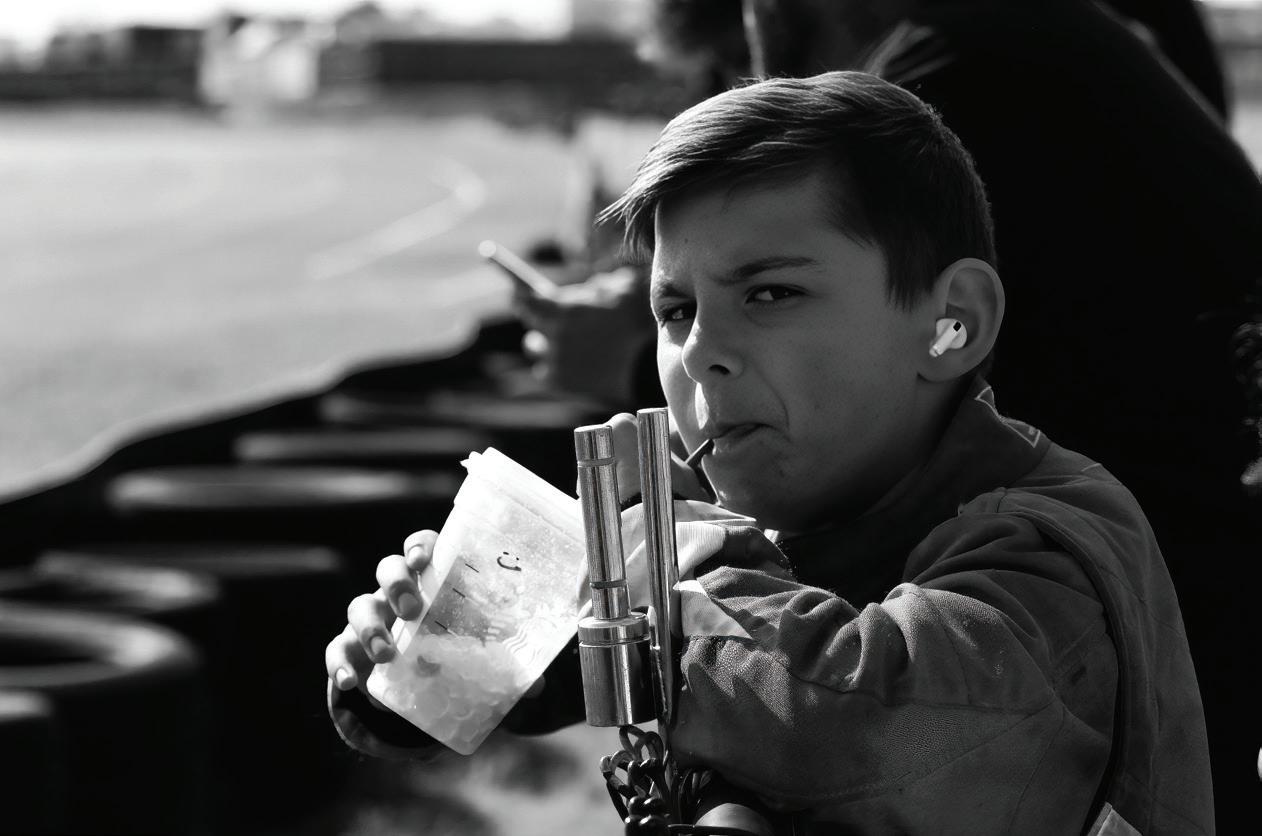







Editor’s Note:
Welcome to the summer issue of Veritas, Paly’s science and technology magazine! As we wrap up another whirlwind cycle, it’s clear that this one has been marked by change, excitement, and a little bit of chaos. From the possible return of the Dire Wolves to finishing the cycle in record time, it feels like we’ve been moving at the speed of light. That sounds like a story idea in itself… oh wait! It is! From Invisalign’s tech-driven approach to dental care to the ARC Institute’s cutting-edge research, we aim to capture the spirit of Silicon Valley and its blend of innovation and tradition.
While you enjoy the warm weather, don’t forget to enjoy this issue!
—William Xue and Arjun Jindal, Editors-in-Chief
Compiled by MACK RELLER and AUGUSTUS SOEDARMONO
“If there’s a legitimate reason why we need to do it [cloning], then it makes sense, but not to just prove that you can clone something.”
— SARAH BARTLETT English teacher
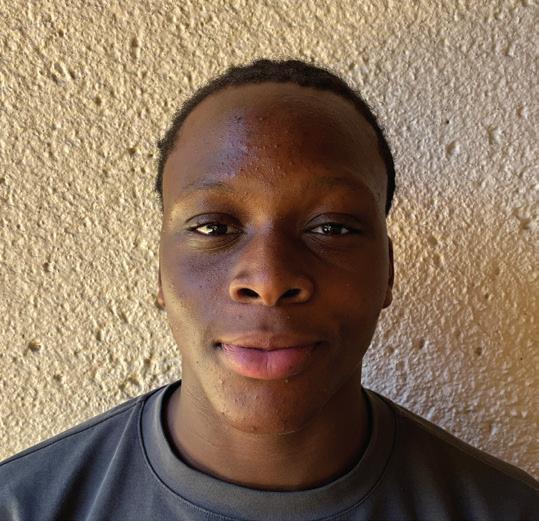
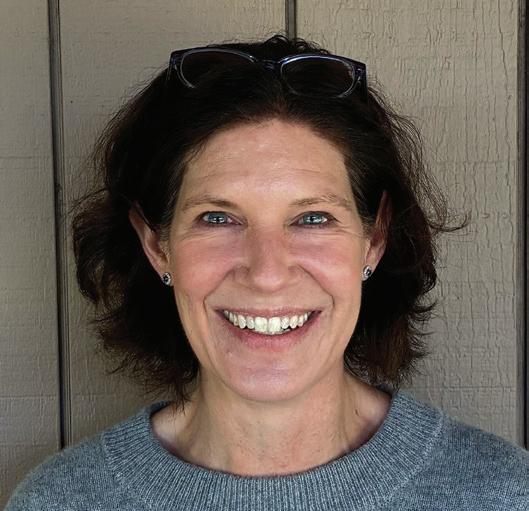
“[It’s] not ethical [to clone animals], because it’s not natural. cloning people and cloning animals, it’s really not ethical, because it’s not the way of life.”
— OKIKIOLA ASOGBA 9th grade
“I think it’s unethical [to clone] because it goes against the natural way of life and the cycle of life.”
— CORMAC WHITE 12th grade

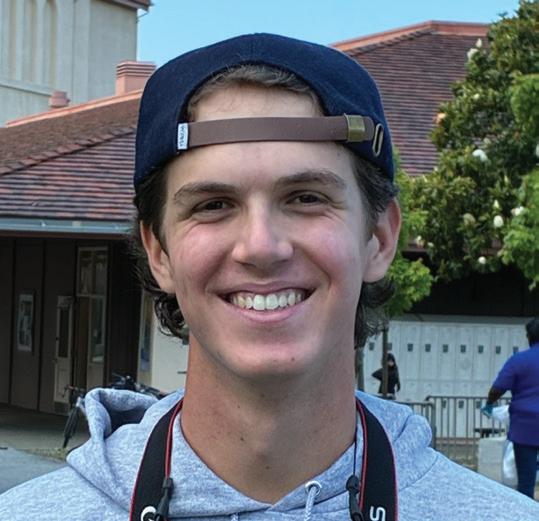
“I don’t think it’s ethical to bring back something that has gone extinct. That’s my personal opinion, because the reason they went extinct in the first place was because the ecosystem wasn’t supporting their existence.”
— TARUNA KHANNA Science teacher
Text by JESHURUN WANG and ALEXANDER LAWSON
Photo by ALEXANDER LAWSON
If there’s one thing that teenagers and older people today can relate to, it’s the pain and nuisance that come with having braces. Becoming mainstream in the 1970s, straightening teeth using brackets and wires has been used for decades.
For a long time, there has been no alternative, forcing primarily teenagers to endure often years of brackets breaking, wires snapping, and constant visits to the orthodontist for tightening.
However, Invisalign, which was invented in the late 1990s with the same fundamental purpose, is finally gaining traction as an alternative to braces.
As a young student at Stanford, Zia Chishti was nearing the end of his ortho dontic treatment with braces. After getting his braces off, his Orthodontist presented him with a plastic retainer, giving him in spiration for a new and far less grueling way to straighten teeth.
Christi then returned to Stanford and presented his idea to Kesley Wirth, who later became the co-founder of Align Tech nology. The two of them partnered up and began working in a garage in Menlo Park to find a way to make their concept a reali ty. And in 1997, they officially co-founded Align Technology.
Align Technology’s Invisalign was first introduced publicly in 1999. By 2018, the product had been used to treat 5 million people. This figure increased to 10.9 mil lion by 2020. As of 2023, the number of people who have used Invisalign has risen to 17 million, including 4.5 million teens.
Weston Bailey, a sophomore at Palo Alto High School, says he would still stick with Invisalign if he were given the choice to choose again.
“I think I would stick with Invisalign because braces seem like they would be a whole lot more painful to have on.” Bailey said, “Invisalign only requires some but tons on your teeth, but it can be a bit sore at times when changing to a new set, but you don’t have to have two metal rods on your teeth,” Bailey said.
Bailey also highlights the strengths of Invisalign as it creates more comfort and fewer obstacles in a person’s daily life.
“If you have dietary restrictions, braces can make it harder since you can’t eat some things, but for Invisalign, you can just take it off and have whatever you want,” Bailey said.
Ethan Chan, a sophomore at Paly, finds his experience with braces to be mostly positive.
“For me, it helped me improve my jaw
who has yet to wear Invisalign or braces, said that he would rather get Invisalign because of the insecurity that sometimes stems from braces.
“I think I would rather wear Invisalign over braces because with braces, I feel like there are not as many people wearing them in high school,” Lin said.
However, contradicting this, Chan expressed his indifference to having brackets on his teeth.
“I don’t think the appearance thing is
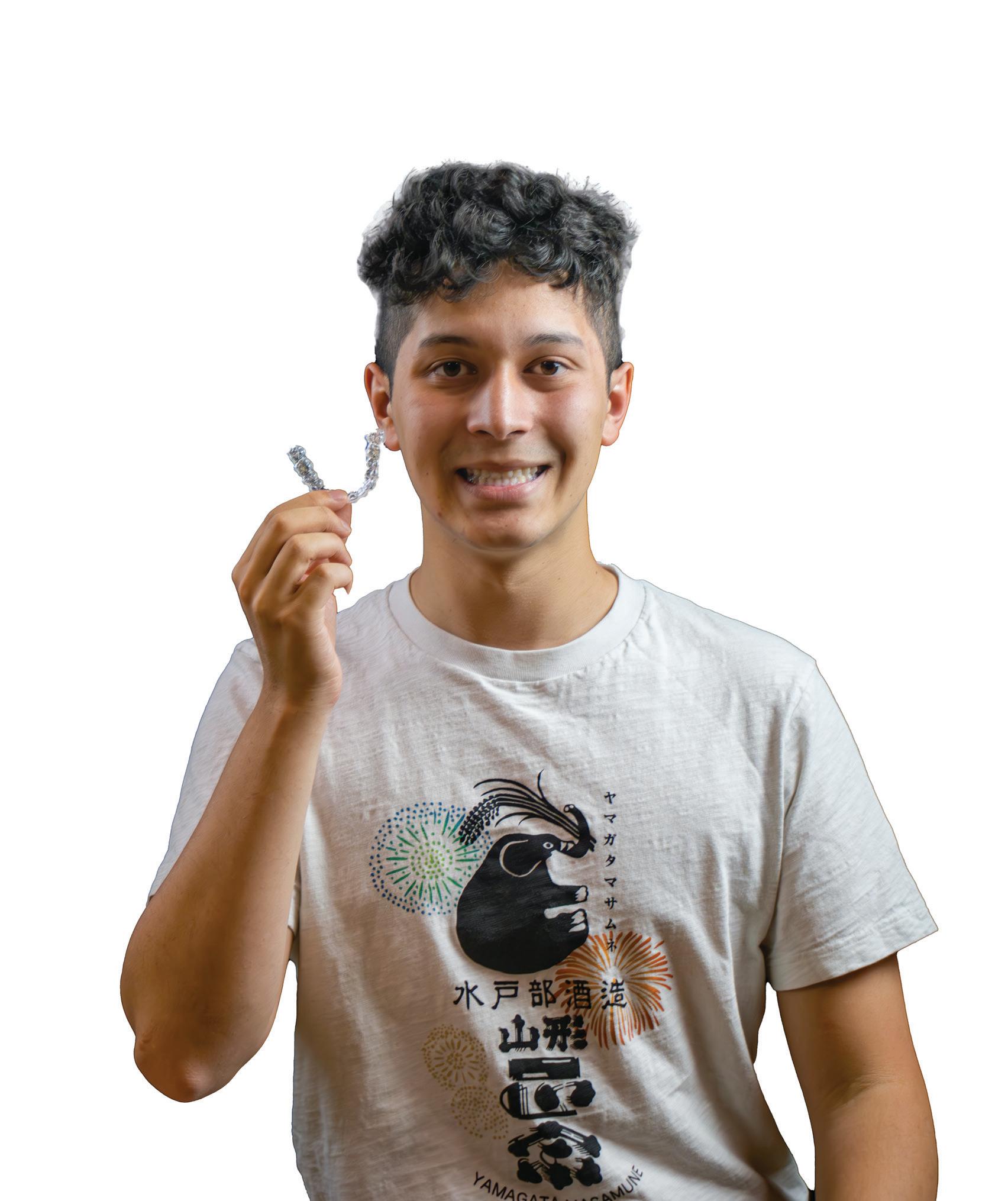
nder cool, luminous lab light, researcher Matthew Carter pipettes a liquid into test tubes, gives a gentle flick to make sure the mixture is perfectly stirred, then carefully puts it back on the tube rack.
Though simply a small tube, its findings will change the lives of many.
Carter is one of many researchers at the Arc Institute but only one of 11 who work is currently investigating the microbiomes of triathletes.
specific project they want to pursue.”
Founded in 2021 by Silvana Konermann, Patrick Hsu, and Patrick Collison, this relatively new non-profit has had a high impact on the local research community as well as the world of biomedical research.
“The most impactful science is going to be cross-disciplinary”
— Academic Affairs Manager Tina Solvik
Located in the heart of Silicon Valley’s tech hub, the Arc Institute is a nonprofit providing individual scientists with grants to pursue high-impact, highrisk research in interdisciplinary science fields, typically focusing on complex diseases.
Amid cuts to government-funded research programs, Arc is maintaining itself as a resource for scientists across the Bay Area to kickstart new research projects. As opposed to the traditional granting strategy of funding a single project, Arc supports researchers individually and allows them to pursue whichever inquiries interest them.
“We really focus on funding the individual, rather than funding a specific project,” Academic Affairs Manager Tina Solvik said. “Whether that is a core investigator who is based at Arc or it’s a faculty member at UC Berkeley who’s getting a $1 million grant from Arc for five years, we’re funding them based on their innovative ideas for the future, but not a
The unique way of funding individual researchers has attracted many more funders.
“Arc has privately fundraised over $650 million,” Solvik said. “And we’re continuing to fundraise for future years, and that enables us to fund what we call high-impact, high-reward, very creative research.”
Arc project grants are funded by the individual investors who are interested in the researcher’s field of study, allowing them to be free from recent federal grant cuts.
“They [researchers] were able to really turn around and start projects on COVID quickly,” Solvik said. “They [Arc Institute] funded around 250 different projects and $50 million worth of research on COVID.”
Aside from the grants that support individual researchers, Arc is also known for its cross-disciplinary research.
“The most impactful science is going to be cross-disciplinary,” Solvik said. “That kind of research is going to be more and more high impact and requires expertise across fields that no one person could have alone. … Connecting machine learning scientists with epigeneticists and chemical biologists and immunologists is really important to science and is really fundamental in how Arc is modeled.”
“Arc has privately fundraised over $650 million”
— Academic Affairs Man-
These donations give Arc another critical advantage, the ability to give out grants quickly. In fact, grants can be given to individual researchers in 48 hours, according to Solvik, who added that the fast grant is something the founders have worked on in the past few years, as a direct result of COVID-19.
In 2021, Arc Institute started as Fast Grants, a small scale grant provider that ensured COVID19 research could be performed quickly without having to go through arduous government pathways.
ager
Tina Solvik
In connecting these scientists, the Arc Institute not only impacts many people, but also becomes a stepping stone in global health discoveries. They do so by allowing researchers to quickly get into labs and make findings.
“That’s the beauty of scientific discovery,” said Xujun Cao, an Arc Institute PhD student working on therapeutics for a rare autoimmune disease that only affects an extremely small number of people.
“Whether the disease you start with affects six people or six million, you can still make a significant impact in the discoveries you make, and in the work you put forward,” Cao said.
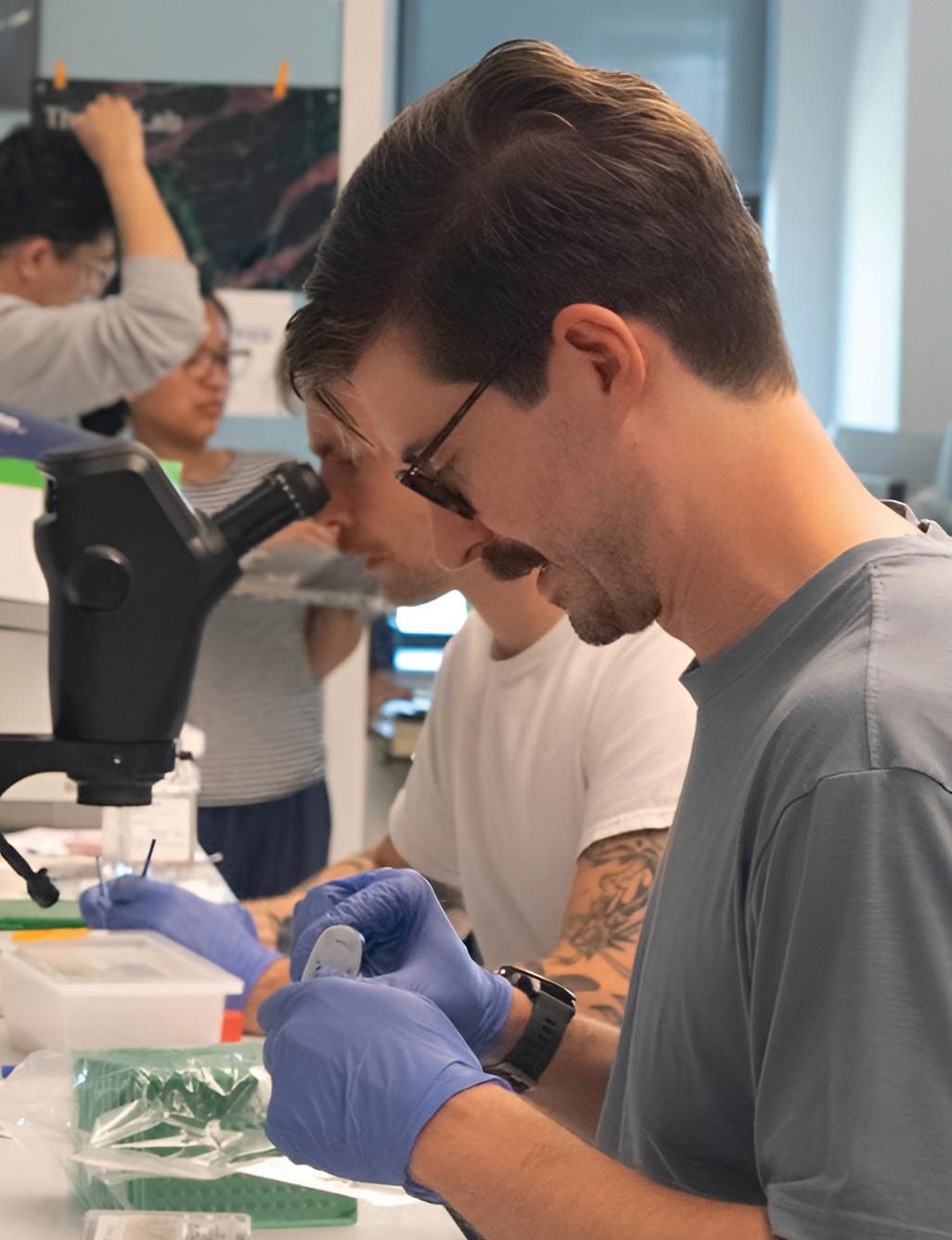
IN THE LAB — Arc Institute researcher Matthew Carter is pipetting substances to be used for future tests. Carter is a PhD fellow in Thaiss lab of Arc Institute, led by core investigator Christophe Thaiss, the team dedicated their efforts in researching topics like elements of the biology of aging, core principles of body-brain communication, and how environmental and lifestyle factors interact with the human body.
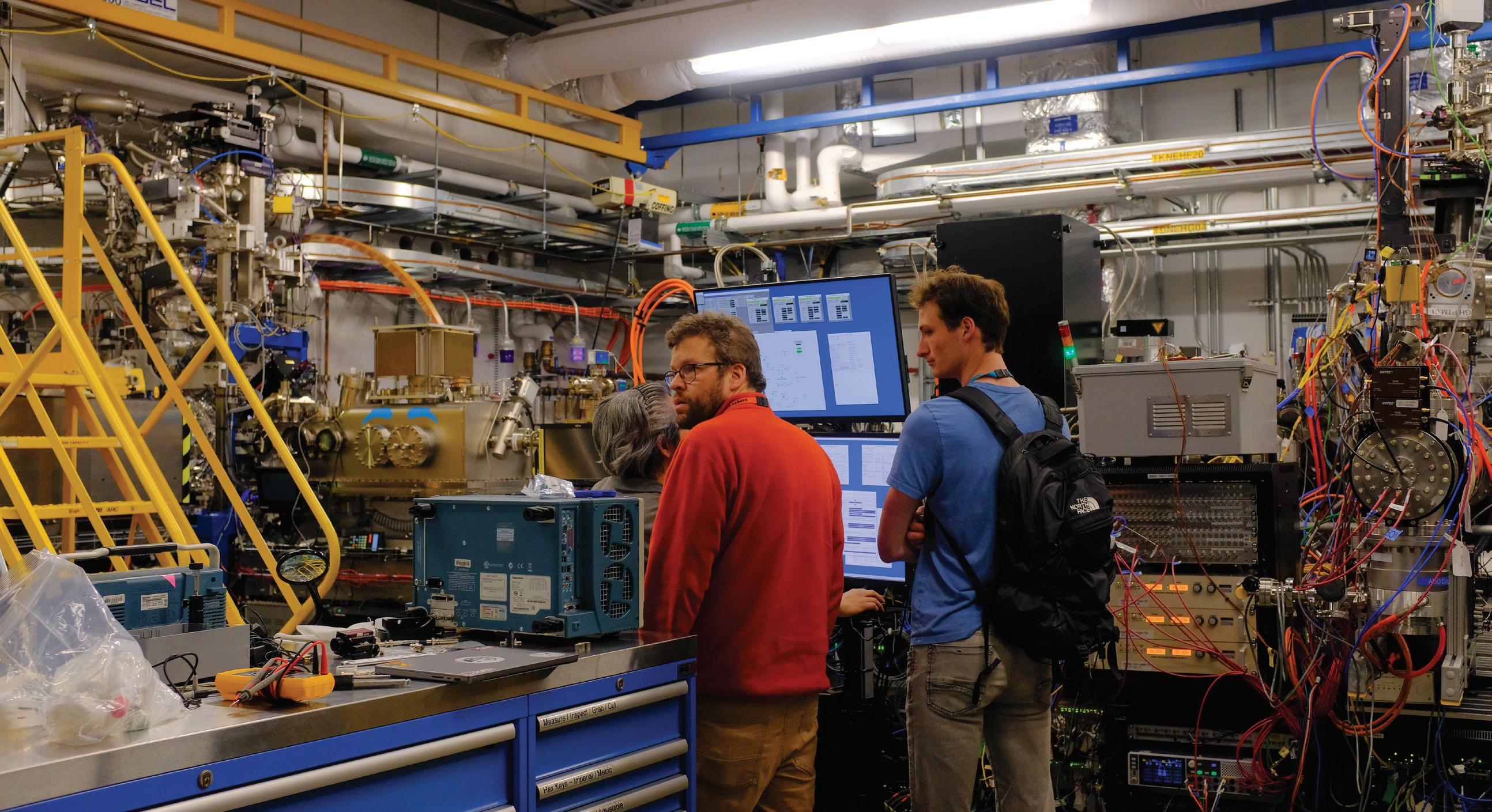
What would happen if two things collide, both traveling at 99.9999999% the speed of light? In a particle accelerator, such as the SLAC National Accelerator Laboratory, charged particles collide with each other every day, giving scientists vital information on the mysteries of our universe.
Sitting on the slopes of Menlo Park, SLAC is one of the world’s longest buildings and a joint project between Stanford University and the US Department of Energy. Since the laboratory’s inception in 1962, research from the center has led to important discoveries in quantum physics, environmental science, and genetic studies, resulting in four Nobel Prize wins.
In April, Veritas was invited to tour the SLAC facility, which spans more than 426 acres of underground tunnels, control rooms, and experimental chambers.
The process of colliding electrons begins at the particle accelerator, a two mile long building where electric fields boost the speed
and energy of particles, and magnetic fields guide and focus their path. At SLAC, this process happens inside two long tubes that seem to stretch endlessly — an aluminum one below used for alignment and a narrower copper one above, where the electrons travel. According to staff at SLAC, over 150 microwave generators, known as Klystrons, push electrons along the accelerator, with each device being 60,000 times stronger than the average household microwave.
Once the beam is produced, it travels to a set of experimental stations known as Hutches. These tightly controlled chambers are equipped with detectors, vacuum chambers, and precision-aligned targets, allowing scientists to conduct research on a variety of different fields. At SLAC, Hutch reservations are free for researchers, allowing physicists from around the world to submit research proposals and experiment with their work at SLAC.
At SLAC, scientists experiment in fields spanning quantum computing to drug de-
sign. Each hutch is designed for a different task and has cutting-edge instruments suited for each task. For example, the above Hutch, known as the Time-resolved atomic, Molecular and Optical Science instrument (TMO), is primarily used to study behaviors at the nanoscale. This can include nanomaterials, molecular biological processes, or fundamental quantum physics. To assist with this, SLAC operates the Linac Coherent Light Source — an X-ray free-electron laser capable of imaging on the scale of femtoseconds (a millionth of a billionth of a second). To put this in perspective, a femtosecond to a second is the same as a second to 32 million years. With this resolution, scientists at the TMO can watch chemical bonds form and break in real time, a feat not possible with any other imaging tool.
ABOVE — Dr. Ming-Fu Lin and his team conduct experiments within SLAC laboratory’s TMO hutch. (Photo by Divij Motwani)
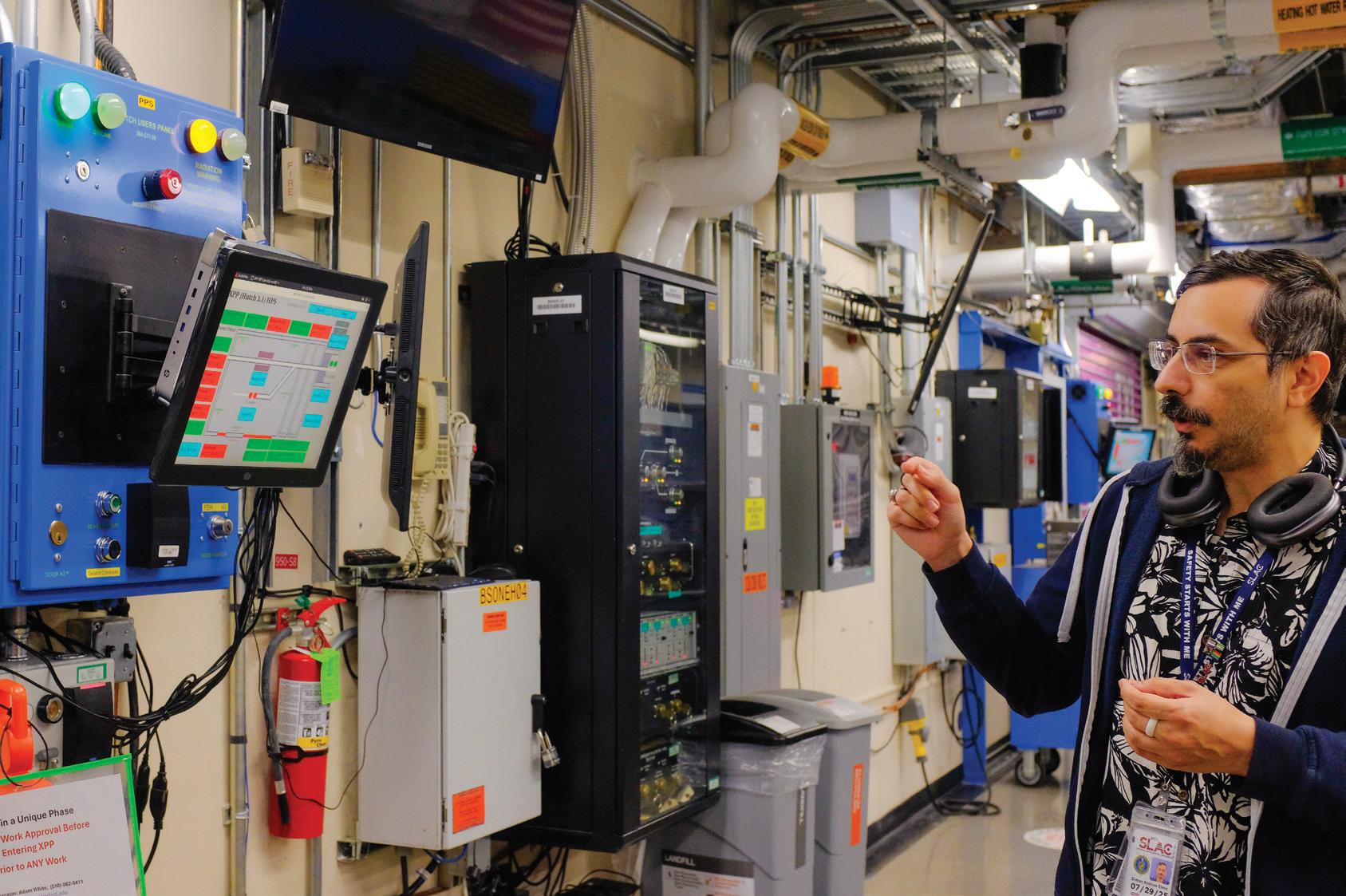
RIGHT — This entrance room outside of the Stanford Linear Accelerator (LINAC) showcases the hardware infrastructure which powers the LINAC’s . The top copper tubs contains propelled electrons, whilst the lower aluminum beams ensure alignment accuracy across the length of the laboratory. To cool down the acceleration chamber, water is pumped through small copper tubes, removing heat from the system. (Photo by Divij Motwani)
LEFT — SLAC system administrator Simon Andrew Elmir showcases the control system for the laboratory’s X-Ray Pump Probe (XPP). The XPP uses ultra-fast laser and X-ray pulses to capture atomic movements in real time, helping scientists study rapid changes in materials, chemical reactions, and biological processes at the atomic level. The pulses are timed in femtoseconds, allowing researchers to see and record atomic level events. (Photo by Divij Motwani)


LEFT — The LINAC at SLAC, stretching over two miles, serves as the backbone of nearly all experiments and facilities at the research laboratory. Originally built for high-energy particle collisions, outputs from the linear accelerator now drives a wide array of cutting-edge experiments, including the LCLS, ultrafast electron diffraction, and accelerator research and development. (Photo by Divij Motwani)
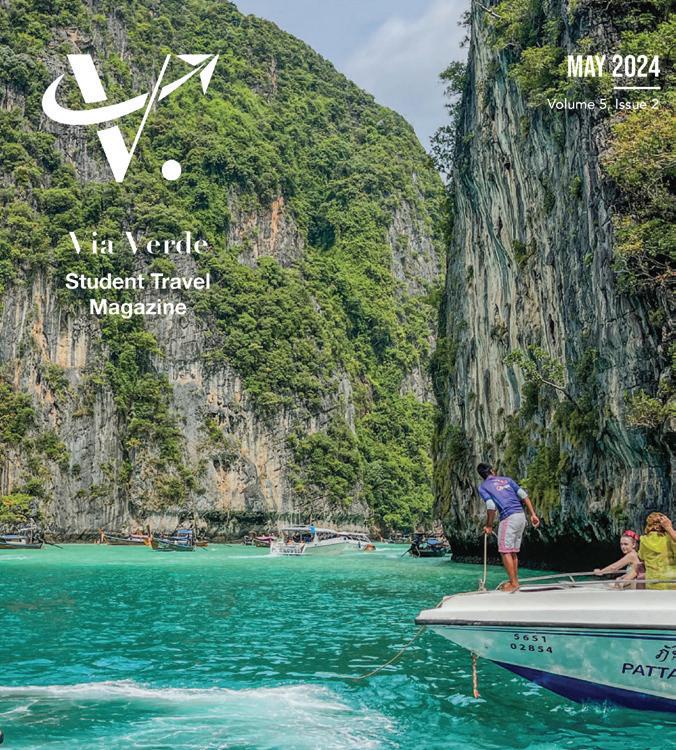
Editor’s note:
Welcome aboard Via Verde! We are delighted to have you travel around the world through a Paly student lens.
Via Verde, Paly’s unique student travel magazine, and serves as a space where students are encouraged to broaden their perspectives on local and international travels with the discovery of new cultures.
In this issue of The Incubator Spotlight, we delve into staff writers Sarina Grewal and Lara Dumanli’s advice for the best day in Santa Cruz to staff writer Anika Nair’s culture shock experience in Japan. Meanwhile, staff writer Karin Blumenfeld reflects on her time working in the coffee fields in Costa Rica and how it’s changed her everyday routine. Lastly, staff writer Salem Coyle shares his opinions on in-flight WiFi.
Via Verde can’t wait to share this new journey with you, traversing the globe, together.
—Cailey Quita, Editor-In-Chief
Arriving at the beach, we were immediately greeted by the loud squawking of the seagulls, children shouting and college students yelling as they played flag football. The beating sun greeted us the moment we stepped out of the car, and we joined the long line of cars paying for street parking. The main entrance to the Santa Cruz Beach Boardwalk was crowded with families, college students, and high schoolers like us, but the shoulder-to-shoulder visitors only added more charm to the oceanside landscape. As we set up our sandy camp, we lay down our beach towels to begin our tanning and turn off our brains for the afternoon. Later, tucked in between the cliffs, a hidden concavity filled with seaweed-filled rocks was the perfect place to play with the waves and draw in the sand. Having a mix of the booming sandy beach and the serenity of the waves was the perfect combination to maintain the best of both worlds.

Text and photos by SARINA GREWAL and LARA DUMANLI
Though the drive to Santa Cruz is full of beautiful scenery, including redwood forests and cliff-top ocean views, it’s also rife with steep turns and moving obstacles — watch out for deer! In the hour and a half that we drove from Palo Alto, we encountered three packs of bicyclists, two Harley-Davidson motorcyclists, and a stray mountain lion. The journey can be dangerous, but it’s also beautiful, and the views are worth every minute of your attention, both there and back.son motorcyclists, and a stray mountain lion. The journey can be dangerous, but it’s also beautiful, and the views are worth every minute of your attention, both ways.



While going to the beach may be seen as second nature for many na tive Californians, there are still some unhidden tricks that are kept a secret to the public.
1. Always, and I mean always, bring an insulated water bottle. Even though you are surrounded by water, the hours of tanning and building forts in the sand will make you so incredibly dehydrated.
2. It’s not only sunscreen that’s important, it’s also tanning lotion. Whether it’s regular tanning lotion or oil you bring from your house, hav ing tanning lotion on top of your sunscreen is the best course of action to make sure you don’t look like you got slapped by the sun.
3. Take the long way, the backroads are a gem. It doesn’t matter if you are in a rush or if you hate the forests, Santa Cruz is not an underground weekend getaway. Not only will you be squished with half of the Bay Area’s population on the 17th at 11 AM on Saturday but you will also be over heated as well.
4. Santa Cruz is more than its beach and downtown! After an amazing beach day, it might be tempting to go straight to downtown, but Santa Cruz is surrounded with small towns like Aptos, Rio Del Mar, and Capitola that have the most dreamiest restaurants. v

IEXITED THE BULLET TRAIN and entered the city of Aomori, in northern Japan, and I shivered as the cold air hit my face.
The past few days were spent navigating the cramped streets of Tokyo, Japan’s southern capital city, blending into the millions of people crammed into the big city. It was a beautiful destination, packed with culture and attractions.
Our days started early and ended late because we visited almost every attraction. From the Tokyo Tower that provided a beautiful view of the city, to eating lunch at the Tsukiji fish market, a packed market where vendors set up stalls early in the morning and sold their dishes.
The area felt alive, with crowds of people pushing against each other in pursuit of their next dish. As we walked from vendor to vendor, excited to eat various foods, my little sisters kept trying to run back to the Tanghulu stand, a decadent dessert where fruit was covered in a hard sugary shell, as my parents and I kept looking for the best matcha.
While we had an amazing time, my family and I (especially my four-year-old sister) were exhausted from the chaotic days spent running around the city and looked forward to the tranquil and peaceful time we would have in Aomori.
Aomori is known as the snowiest city in the world, with a population of only 100,000 people. It’s filled with rich history and a vibrant culture, being home to a UNESCO World Heritage Site, Shirakami Sanchi, and is renowned for its Fuji apples. During our stay, we realized that, unlike Tokyo, a metropolitan city filled with foreign tourists, Aomori was more isolated, and the tourists that we saw at the resort were from other cities in Japan instead of different countries.
While I was excited to immerse myself in a more traditional culture, I slowly realized that no one in Aomori spoke much English.
In contrast, I have been to countries that don’t speak much of it either, like India, however,I am still able to communicate and understand in Hindi. So being in a place where I didn’t understand anyone and did not understand me was a culture shock especially when I was asking for prices at a store or directions to the historic sites.
As we spent more time exploring Aomori, I started to slowly recognize certain words in Japanese. For example, at restaurants, I was able to differentiate meals, such as ramen, that had beef, chicken, or pork.
I was also able to understand common signs like stop signs or restroom signs. This struggle also taught me a lot about Japanese norms.
Now, I knew to look for set stations at every restaurant for hot water and sodas instead of asking a waiter or following polite customs like using tongs to pick up pastries at cafes or taking off shoes at certain restaurants.
What began as a nightmare, being in a city where no one understood me, quickly turned into an amazing experience. I was able to immerse myself fully in Japanese culture and embrace the local lifestyle for a few days. Now, when I travel abroad for college or work and face language barriers, I’ll carry the confidence I gained during my time in Japan. v
Text by Anika Nair


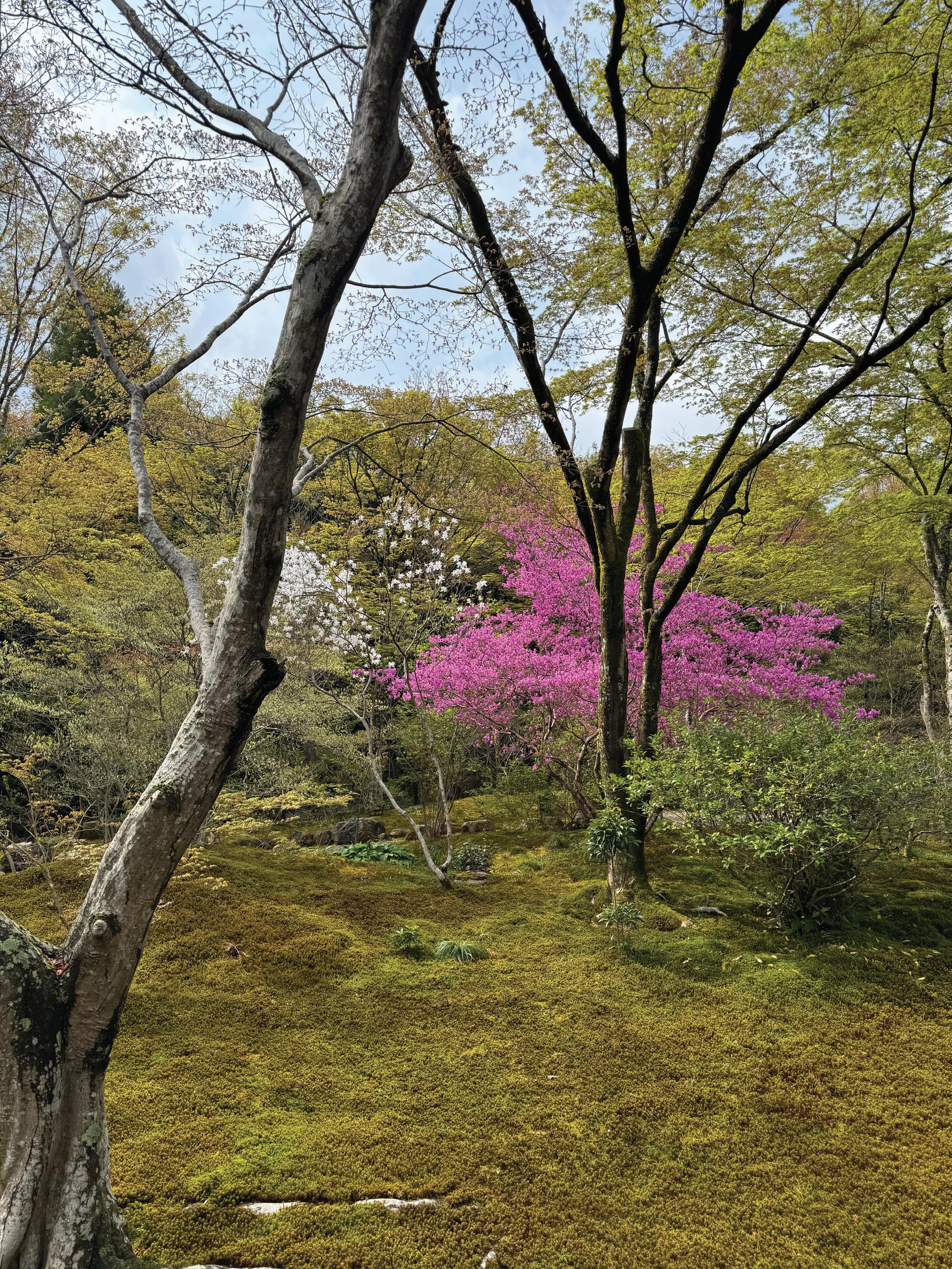

I’VE ORDERED A MEDIUM PHIL-
TERED SOUL with medium oat milk, medium sugar, and light ice from a
Philz Coffee barista nearly every day. My friends, family, and even my first-period teacher, who sees me walking in with my Philz cup in hand each morning, know one common fact about me: I love coffee.
Despite being a coffee lover for over three years, I had never thought about where the coffee might have come from.
Over spring break, I went on a service trip through Dream Volunteers, a 501(c)(3) public charity. While most of their service trips focus on bettering education by building and decorating schools, their Costa Rica trips highlight sustainability through organic coffee farming because of Costa Rica’s unique cloud forests and coffee industry.
All 13 high school volunteers — including me— from Silicon Valley arrived in Costa Rica eager to help organic coffee farmers. However, when we got to the coffee plantations, it was no walk in the park, literally.
The plantation fields were densely
packed with coffee plants and moist soil from the daily tropical rain. Walking through them to fertilize the plants and throw out dead branches gave me scratches and coated my boots in dirt.
“Could you grab me another bucket of fertilizer?” I yelled to my friend over the halfacre of coffee plants.
With each bucket dumped into the fields and each scratch I got from the post-harvest barren branches of the plants, my appreciation for the farmers who provide my Philz Coffee each morning grew deeper. Understanding the difficult work that goes in and the low pay that comes out.
After a morning of working in the coffee fields, all of the volunteers would return to the center of San Pedro, a soccer field and multipurpose room, to engage in Costa Rican activities organized by Dream Volunteers. We would play soccer, take salsa lessons, or cook up some tortillas with local teens.
Despite the handmade soccer goals being on the verge of breaking, rain dumping on us, and me not having played soccer since 2nd grade, I had a blast. Being together, boys and girls of all different ages, made me forget about my stresses back home.
The highlight of my work hours was the fruit the moms from the 300-person town of San Pedro would cut up for the volunteers: watermelon, melon, and, on special occasions, passionfruit.
Text by KARIN BLUMENFELD
Our evenings would close with a dinner and a reflection, where we would look back on the day. Most vividly, I remember writing a letter to Roberto, a farmer I had met earlier.
He told me about his experiences in the US and needing to come home for his family. He emphasized Costa Rica’s peaceful nature and made sure to send me home with a sweet passionfruit from his farm.
I could not get passionfruit like this at home, nor could I get coffee as varied in hints of flavor. I was not going to start playing soccer in the rain, or growing my own coffee farm, but I returned home appreciating little aspects of my life, admiring small parts of nature, and understanding specific details of the processes it takes for products to get from farm to table.
After a turbulent six-hour flight and a week working on organic coffee farms, my routine Philz Coffee order changed for the first time in three years. Now, I hand the barista my own cup instead of their paper ones, knowing what will come back in it was made with care and diligent work or even opt to make my own coffee supporting organic farmers at home. v
IN THE FIELDS — High school junior, Leila Berman walks in the dense plantations scattering fertalizer. She takes in the beauty of the plants while replenishing them for the future. Photo by Sabrina Alvarez

THE TERM “FIRST WORLD
PROBLEMS” crops up in daily conversation commonly nowadays. You know the type: hot shower going cold in 30 minutes, losing the television remote, getting stuck in traffic when you left the house early. Life is full of minute annoyances, the little things that turn a good day into a bad one.
Though less common, the annoyance of being disconnected while on a flight is a sting known all too well by most individuals you’ll talk to.
Everyone’s been there — needing to fill out an important form or finish a pressing assignment, until, BAM — the flight attendant calls for all passengers to switch their phones to airplane mode. Stressed and heartbroken, we are stuck, unable to do what urgently needs to be completed until we land again.
However, on my most recent flight to Seattle, my anticipated stress melted away as the flight attendant brought up
something I wasn’t aware of hidden within their typical speech: free in-flight Wi-Fi. Although it isn’t something new, it’s always been a bit of a luxury, incurring an additional $8 to $12 fee. Free in-flight Wi-Fi is comparatively much newer and certainly a great convenience. So I thought, at least, as I began working on an essay that I assumed I wouldn’t be able to work on until landing. And yet, that flight was missing something integral.
Typing away, I realized that despite the stale cabin air and white noise, it didn’t much feel like I was flying at all. Although I was able to do what I wanted on the airplane, I was losing a key part of the airplane experience.
It’s undeniably annoying to be unable to access the internet when you have things to attend to. But in a day and age when one can connect from almost anywhere, the airplane provides something we lack as a result: a place where one can disconnect without shame. There is no feeling that one ‘could be working right now’ instead of
whatever they’re doing instead — there’s no ability to work at all! Changing the plane just another potential workspace takes away from what makes being in the air so unique.
The isolation provided by the airplane allows the mind to wander and allows us to engage with the “less important” tasks we often neglect. Your work takes priority when you can, sure— but when you really truly can’t, that book you’ve been meaning to read, airline-provided movie, and mobile game you haven’t cracked open in five years all start to look quite appealing. What we lose in productivity while flying, we gain in mundane joy.
People hate first-world problems a lot more than they hate disconnecting, but the hidden value of our plane-ride annoyance can’t be understated. So even if free WiFi grows to be more prevalent, I urge you to pull away from it and do something else— something unproductive— if only for a few hours. The world will still be waiting for you when you land. v

